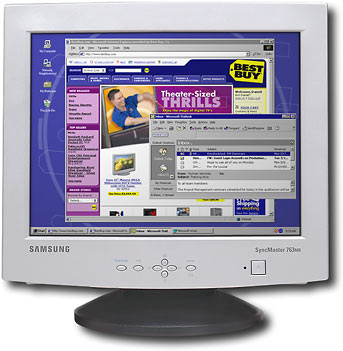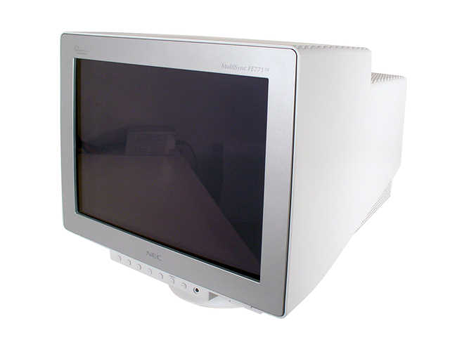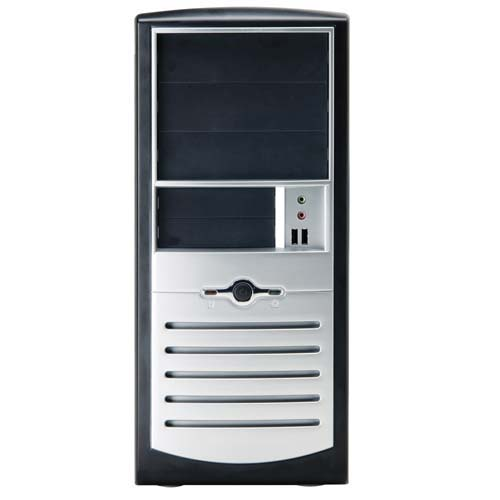Weekly Buyer's Guide: Entry Level System - August 2004
by Anand Shimpi & Larry Barber on August 9, 2004 12:00 PM EST- Posted in
- Guides
Monitor
Recommendation: Samsung SyncMaster 17" Flat-Tube (model 763MB)Price: $150 shipped

Samsung's SyncMaster series of monitors are very popular for price-conscious buyers. With a 0.20mm dot pitch, 1280x1024 max resolution, and 3-year manufacturer warranty, you're getting a good bang-for-your-buck monitor. You can pick up this monitor at your local Best Buy if you don't feel like waiting several days for your monitor to arrive in the mail. We suggest calibrating your monitor for maximum clarity if you do a lot of desktop work. Consult your manual or an online guide on how to calibrate a monitor.
Monitor Alternative: NEC Diamondtron 17" CRT (model FE771SB)
Price: $183 shipped

This NEC model is one of the lower end models of the famous Diamondtron series of monitors. Max resolution is just 1280x1024 and dot pitch is a mediocre 0.25mm. However, the clarity and viewable area (16") of this monitor are better than the Samsung SyncMaster 763MB, and at just about $33 more, it is a nice little upgrade if you're willing to spend the extra dollars.
Computer Case
Recommendation: CaseEdge TS1 Mid TowerPrice: $40 shipped

You can purchase this case online at www.pcclub.com or go to a local PC Club to pick it up. Not only is the black and silver edition of this case very good looking, but the set-up is very easy to use and convenient in general. For one, the motherboard mounting screws come installed in their proper holes, a welcome change from having to screw them in by hand. Secondly, the hard drive and optical drive bays contain plastic clips that allow you to install your drives simply and easily without screws. All in all, this case basically comes "pre-installed", and even includes a 300W PSU (power supply unit). Any AMD or Intel approved power supply will do for a budget system, considering how little power a system like this draws, but if you're feeling extra cautious (thinking about future upgrades), picking up a Sparkle 300W PSU is a fine choice. The price of a Sparkle 300W PSU is about $23 shipped online.
Alternative: Foxconn Super Case 100-G2-P4 Mid Tower
Price: $45 shipped

While this case isn't quite as easy to use or as aesthetically appealing as the CaseEdge TS1, it is still a fine computer case with all the space that you'll need for your budget system. It comes with an AMD approved 300W PSU, but as we said before, you can always opt for a better 300W power supply if you feel like you need an especially good PSU for future upgrades. Still, a free PSU is usually never a bad thing.
In the end, as long as you purchase a case that accepts an ATX motherboard, the choice of computer case is completely up to you, the consumer. There are many aesthetically appealing computer cases out there, so don't let our preferences stop you from exploring other computer cases online or at a local retail outlet like PC Club, Best Buy, CompUSA, etc.










30 Comments
View All Comments
Booster - Thursday, August 26, 2004 - link
I have to add I can't agree on this value system configuration to the extent that I'd call the choices really unpractical. That system of yours may look good on paper, but have you actually tried to use such a system daily? I bet you'd hate it in a week, and here's why.First, the monitor choice. It's by far the most important choice of all, and you recommend a crappy Samsung CRT. This is ridiculous. Try to read web pages, e-mails and text documents on that CRT and I bet you get a headache after no more than just 2 hours (at least that's my personal experience). The only thing that CRT is good for are games, movies and other multimedia stuff, but not for doing any actual work. And games and movies aren't the point of a budget system, according to your own words. Now that LCD prices are rapidly declining, a 15 inch LCD (cheapest of the cheap, with no DVI, in the $300 range, just $150 more than that CRT, and without unnecessary expense of a $50 video card - only $100 - you'll get so much just for additional hundred bucks!) would be so much easier on the eyes of a budget user. That would also eliminate the need for a costly $50 video card, which is, simply put, a complete waste of money in that system (because even the worst quality integrated video would be sufficient to produce no-ghosting image on a 15 inch LCD with 1024*768 resolution at 60 Herz).
Second, the CPU choice. Athlon XP is a bad choice. It has more power than the Celeron? It sure does, but that's not the point of a budget system, as you say. Price and reliability are more important, I agree, then you need a Celeron, b/c say a 2.0 boxed Celeron costs the same, but it's by far more reliable - it wouldn't burn, in fact it's indestructible, and the boxed cooler is of much higher quality than Athlon XP's bundled cooler, not to speak lots quiter. Performance? Who needs performance in a budget system like that, but the Celeron is fast enough to run anything that system is supposed to run, anyways. Plus take into consideration that you can get a completely integrated Celeron motherboard (with onboard video) for much less than the ASUS board you reccomend, and that the Celeron system would run really cool and quiet and wouldn't require extra case coolers like any Athlon system does, not to speak of high power (and thus expensive) PSUs - a no-brainer choice IMO.
The case - who needs an ATX case? It's too big, and since there wouldn't be much expansion, a Micro ATX case would suit this system so much better.
I have to add I agree with this guide's choice of a Seagate hard drive, I was going nuts when I saw you recommend WD in previous guides (those drives suck, they're too loud and there's pretty much nothing else they offer over competing products).
xilef - Friday, August 13, 2004 - link
How about this system that includes dual channel, Barton Core, DVD and a subwoofer for less money. Shipping is less than $50. I've saved this system at Newegg as AugustCheapo.POWMAX ATX Aluminum Mid-Tower Case with X-Window, Model "ALV90-511SEL" -RETAIL 35
Rosewill 52x32x52x16 CD-RW & DVD Combo Drive, Model C523216, Retail 37
Western Digital 80GB 7200RPM IDE Hard Drive, Model WD800BB, OEM Drive only 62
Crucial 184 Pin 128MB DDR PC-2700 - OEM (2 pieces) 64
PROVIEW PS709s 17" CRT Monitor –RETAIL 89
ASUS "A7N8X-VM/400" nForce2 IGP Motherboard for AMD Socket A CPU -RETAIL 82
AMD Athlon XP 2600+ "Barton", 333MHz FSB, 512K Cache Processor - Retail 95
Logitech Z640 5.1 Speakers -RETAIL 49
Total 513
Hoot - Friday, August 13, 2004 - link
Systems recommended by popular sites like this one always seems to recommend an abit or asus, and they are not always the best choice. How about an mATX system with a very reliable Biosta M7NCG 400 - and it's also overclockabe if you get rev 7.2 (full voltage and multiplier control and will run mobiles.APEX Silver Mid-Tower Super Tower with 400W Mustang Power Supply, Model "PC-146/400W" -RETAIL (newegg $28.00)
Biostar M7NCG 400 mATX (better than the Asus and has IGP to use when you sell the video card yto upgrade. ($65.00)
Samsung 160 Gig HDD at newegg (IDE $87.00)
512 MB Kingmax newegg $75.00
Power color 9600 Pro newegg $126.00
*This system get't you alot more storage. Better memory as most will not want 256 MB stick for a more power hungry system later - but add to the other 512 stick later to make a gig of ram. Also the powercolor 9600 pro is cheap and very good for gaming.
razor2025 - Thursday, August 12, 2004 - link
I think for the money, a good alternative is Nforce 2 IGP board. It'll save anywhere from $30-40 for not having to get a graphic card. The performance of integrated GF4 MX is also decent enough to compete with GF 2 GTS/Ultra in 3D games. With the $30-40, you can add $10-20 and get two stick of same memory for dual channel. In a nut shell, for just adding $10-20 more, you can have a system with 512mb vs 256mb (big difference in real-world, even for budget PC), and a similar 3D performance (maybe a little slower than the 9200(SE).Chaotic42 - Thursday, August 12, 2004 - link
An XP 2400+ is $1 more. I'd have gone with that instead of a 2000+. Heck, a 2200+ is $6 cheaper.Degrador - Wednesday, August 11, 2004 - link
I would think that entry level being a general field should include just about all fields - average home users, web surfing, office apps, games, playing music - these are things most users would be doing, and most would be doing all of them (some concurrently even). Entry level is usually for family computers - where everyone needs to use the computer. Mostly 'cause they don't have the budget to have different computers for different family members, each comp with specific tasks.For instance, with a friend's family, his dad uses the comp for Autocad (he's a tool maker), his mum uses it for tax / financial management stuff, and he and his sister use it for school / uni work, playing music, and games.
gherald - Wednesday, August 11, 2004 - link
Entry-level w/o a specific label means the most general field imaginable, i.e. average home users, office workers... you know, mainstream stuff. Video editing, gaming, and the like are all distinctly special cases.ceefka - Wednesday, August 11, 2004 - link
If you lable a system "entry level", I ask what field.What would make an entry, mid-range and high end gaming, video editing or DAW PC? Seems like we're talking about 9 different machines. Or you can make suggestions what to add or change depending on what you want the machine to do.
Would it be possible to do a few benchmarks on the suggested configurations?
gherald - Tuesday, August 10, 2004 - link
"entry level gaming" == "mid-range" in my bookBut if you actually think this entry system would be a workable base, it's not to hard to figure out what to change.. 512mb, a 9600, and definately go with the alternative Abit NF7 and 2500 Barton picks.
Such a thing doesn't warrant a seperate article.
Z80 - Tuesday, August 10, 2004 - link
Good article, I agree with all of the recommended components. I'm glad you didn't skimp on the monitor. A quality monitor can make all the difference in how someone perceives the usability of a system. I'd like to see an article on an entry level gaming system. I assume it would only entail a couple of minor upgrades to this system configuration.